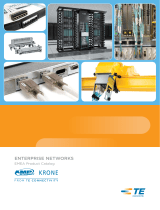
Here is the right cable for making
MT-RJ connections.
Here is the right cable for making
MT-RJ connections.
MT-RJ Multimode Fiber Optic Cable
© 2007. All rights reserved. Black Box Corporation.
FREE 24-hour Tech Support: 724-746-5500
blackbox.com

2 of 2
8/1/2007
#22938
724-746-5500 blackbox.com
FEATURES
• MT-RJ connector has familiar RJ latch
for easy, intuitive use.
• Smaller duplex MT-RJ connectors enable
more terminations in smaller areas than
traditional SC connectors.
• Double current fiber count density.
• Uses industry-leading composite
ferrule design.
OVERVIEW
These MT-RJ fiber optic cable interfaces are the most
efficient of duplex (two-fiber) connectors. They use only half
the space of SC connectors, the traditional interface for fiber
optic applications. MT-RJ cables can achieve the same number
of connections in a given area as copper—a feature quickly
making MT-RJ the standard when it comes to fiber cabling
applications.
MT-RJ cables are easy to install in the field, too. Just push
the connectors together, and when you hear that familiar
“click,” you’re done.
This cable also features an MT-style ferrule, a wrap-around
brace located where the connector and the cable meet. By
reducing stress at the cable/connector interface, the ferrule
prevents breakage and protects the cable from installation
stress and bending in tight applications.
Available for multimode applications, these fiber cables
are durable. Over 500 cycles, the multimode cable reflects a
change of ≤ 0.2 dB. Insertion loss is also low. For multimode
fiber, 0.2 dB is typical and < 0.75 dB is the maximum loss.
TYPICAL APPLICATIONS
Perfect for your MT-RJ equipment, including line drivers,
switches, muxes, routers, and bridges.
Item Code
MT-RJ Multimode Fiber Optic Cable, Duplex, PVC,
62.5-µm/125-µm
MT-RJ–MT-RJ
1-m (3.2-ft.) EFP080-001M
2-m (6.5-ft.) EFP080-002M
3-m (9.8-ft.) EFP080-003M
5-m (16.4-ft.) EFP080-005M
10-m (32.8-ft.) EFP080-010M
Custom Lengths EFP080
MT-RJ–ST
®
1-m (3.2-ft.) EFP081-001M
2-m (6.5-ft.) EFP081-002M
3-m (9.8-ft.) EFP081-003M
5-m (16.4-ft.) EFP081-005M
10-m (32.8-ft.) EFP081-010M
Custom Lengths EFP081
MT-RJ–SC
1-m (3.2-ft.) EFP082-001M
2-m (6.5-ft.) EFP082-002M
3-m (9.8-ft.) EFP082-003M
5-m (16.4-ft.) EFP082-005M
10-m (32.8-ft.) EFP082-010M
Custom Lengths EFP082
Fiber cable construction.
Fiber optic cable consists of a core, cladding, coating,
strengthening fibers, cable jacket, and a ferrule.
• Core: A single strand of glass or plastic, this is the physical
medium that carries optical data signals from a light source
to a receiving device. It is measured in microns (µm) by its
outer diameter. Typical diameters are 50, 62.5, and 100 µm.
• Cladding: A boundary layer around the core that contains
and refracts light waves, allowing data to travel the length
of the fiber.
• Coating: A plastic layer surrounding the core and cladding.
It protects the cable from severe bending, reinforces the
fiber core, and protects against shocks.
• Strengthening fibers: A layer, made typically of Kevlar
®
,
that prevents the core and cladding from being crushed
and reduces cable tension during installation.
• Cable jacket: The outer layer of any cable. For fiber, most
jackets are orange, but may also be black or yellow.
• Ferrule: A flexible brace located at the jack/cable interface.
Thickest at the jack, it protects the interface from bends
and breaks.
Technically Speaking
TECH SPECS
Compliance — ISO/IEC 11801, TIA/EIA 568A, ANSI, IEEE
Durability — Over 500 cycles: Multimode: ≤ 0.2-dB change;
Jack Depth — 2.4 cm (0.9 in.)
Insertion Loss — Multimode: 0.2 dB typical, < 0.75 maximum
Reflectance — Multimode: -20 dB minimum
/


